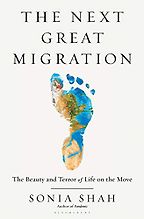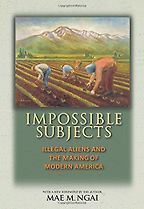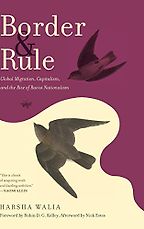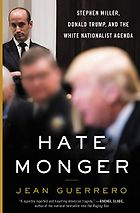We’re discussing books about immigration and race. Just to start out, can you outline why that’s an important topic to understand more about?
A lot of people think of borders as a natural part of the world that we live in, something that all countries should have and have always had. I try to question that idea, to make the case that borders are a fairly new phenomenon. They have to be justified and produced through the language and actions of politicians, leaders, and media. That language is often about race.
I started to be interested in the issue of race and immigration, particularly in the US context, with the rise of Donald Trump because he was so explicitly racist in his framing of immigration and the border wall. I wrote my new book, White Borders, to tell that history, to understand what the connection is between immigration laws and ideas of race. Over the last few years, the use of immigration controls to exclude other groups has become an even more important part of the politics in a lot of countries around the world, not just the US, and almost always it is a racialized exclusion. There are some types of immigrants that are perceived as being ‘acceptable’ while others are not. So, the books that we are talking about today all do a good job of looking at different aspects of that relationship between race and movement, between race and immigration.
You mention Donald Trump, but it’s not at all a new phenomenon, is it?
Absolutely not. Donald Trump is what made me look harder at the connection between race and immigration, but what I found when I wrote White Borders is that all of the US’s immigration laws have a foundation in racial exclusion. The US did not have any national immigration laws until the 1870s and 1880s. It started with the Gold Rush and Chinese people arriving in California as the West Coast became part of the US. The laws from that era are not subtle. The 1882 law was called the ‘Chinese Exclusion Act.’ It did exactly that, preventing what, at the time, was described as an invasion of the Chinese who were bringing diseases, dangerous drugs like opium, and were a threat to the white culture of the United States.
What I do in White Borders is look at all of the immigration laws and rules after that, and they are all based on the same logic of racial exclusion. In 1924, it was the dangers of Jews coming from Europe, as well as Southern Europeans—who were not ‘white’ in the same way that the Northern Europeans who lived in the US were. The 1924 law—the major immigration law that is the foundation of our current system in the US—is all about protecting a white race.
We see that same logic today. Donald Trump talked about immigration in those same terms, and it has continued since he left office. The Fox News host Tucker Carlson talks about the ‘great replacement theory’, which is an old idea that nonwhite people are going to replace whites in the United States.
In your book you mention that Adolf Hitler cited American immigration policies with approval in Mein Kampf. I thought, ‘Wow, it’s hard to have a more damning assessment of a country’s immigration policies than that.’
There is a book, The Passing of the Great Race, written by Madison Grant in 1916. There are some stories that Hitler called it ‘his Bible’ and it was in his bunker when he committed suicide at the end of World War II. Hitler wrote in Mein Kampf that the 1924 Immigration Act was a model for what Germany should do to protect the white race from the threat of these other groups. For him, it was Jews and immigrants. In the US, it was immigration and slavery that was the foundation of racial exclusion.
Let’s look at these issues in more detail as we go through the books. The first one on your list is called Travelling While Black: Essays Inspired by a Life on the Move. The author, Nanjala Nyabola, writes at the beginning, “this is not a travel memoir” but it kind of is, isn’t it? Tell me about it and why it’s on your list.
This is the best book I have read so far this year. It is hard to classify. In some ways, it is a memoir about her life. It also has travel stories. At the same time, it is grounded in academic thought. The book is beautifully written, engaging, and the stories are fascinating. Each chapter takes the reader on a journey by posing a question, and then telling a story that illustrates it. Then, at the end, Nyabola switches the view a little bit, which brings a deep insight that you might not have had at the start. It reminds me of some of James Baldwin‘s essays, in the way that the view changes as you are going through it.
Can you give an example that you particularly like in the book?
There is a chapter about visiting Haiti, talking to people there, and getting to know the place. She has a position that gives her insights into privilege. On the one hand, she is a Kenyan woman who has experienced the world as a Black woman moving through space. At the same time, she is highly educated with degrees from major US and English universities and can move as a privileged person. She can be inside and outside at the same time. That is the power of the book, it shows that privilege is varied in lots of different situations, but it is always at someone else’s expense.
Let’s go on to the next book on your list which is The Next Great Migration: The Beauty and Terror of Life on the Move by Sonia Shah. What’s this book about?
Sonia Shah is a journalist who seems to be about five years ahead of the rest of us. A few years ago, she wrote a book about pandemics and presaged the moment that we are living in right now. This book does a little bit of the same thing. It’s a big book that asks us to rethink the way that we understand movement and fixity. Lots of people have written about the idea that the history of humanity is a history of migration. Over thousands of years and most of our history as species, humans have moved. We were hunter gatherers that were not fixed in place. The idea that we are place-based, that we are identified based on where we are born, is a new one.
Get the weekly Five Books newsletter
But what Shah does really well in this book is make the case that we should look at the animal and plant worlds in the same way. She argues that our ideas of things like ‘invasive’ species or ‘native’ species are shaped by the same incorrect ideas of fixity that we imagine in the history of humanity. A lot of that is based on our presentism. We live the world in a 75-year chunk and so we see what feels like fixity. During our lifetimes, things do not change that much, so we tend to think things have always been in these places and with these configurations. Shah asks us to take a step back and take a longer view of human history, as well as plants and animals. It is a history of movement, not fixity.
Okay, so let’s go on to Impossible Subjects: Illegal Aliens and the Making of Modern America. This is looking more directly at race and immigration, isn’t it?
Yes. This book is by Mae Ngai, who is a well-established historian here in the US. This is the only book on the list that was not published in the past two years. Impossible Subjects is a classic text, it was the first book that really demonstrated the relationship between racist ideas and immigration restrictions in the United States. She shows that notions of citizenship and belonging are not things that are fixed, but rather are created through media, through discourses in a society, and then get put in place through laws. She argues that the laws both reflect the views of a particular time, but then also create and bring into being the exclusions and categories of white and nonwhite that were inchoate before they were put into law.
“The unusual period is the 1960s through the early 2000s, when racist thought was pushed to the side”
The book focuses on the early period of US immigration law, but the histories that she is tracing from the 1920s are still affecting us today. That 1924 law gets revised in 1952, and then again in 1965. That is still the immigration law that we have in the United States. So, the idea that there should be quotas for how many people can come in is still in place. The configurations have changed, but we are still operating under the same general parameters that were put in place in 1924. Many of the people on the right, who are pushing for more restrictive systems, will often refer back to that 1924 law as the model, as what the US should be aspiring to recreate in the country. You have to understand the history that she describes in that book in order to understand what is happening in the present.
Tell me about Harsha Walia’s Border and Rule: Global Migration, Capitalism, and the Rise of Racist Nationalism.
Harsha Walia wants us to think big. It is a book that asks us to see borders not as an object, in and of itself, but rather as part of a much larger project of colonialism, the expansion of the state, and of racial capitalism. Essentially, she argues that you cannot think about indigenous rights, minority rights, and immigrant rights in a vacuum. All of these are interconnected and part of an ordering regime of racial state capitalism. Walia argues we should not focus on individual countries, but rather should think about this as a global system of capitalism that excludes people based on racial grounds and produces racially uneven results. Borders are a system of dividing up the majority of the people in the world and separating them from each other so that they can be managed. Then wealth can be extracted from their labor. The privileges of the wealthy few are protected by fragmenting and containing the majority of people in the world.
People are excluded by race, but they’re also excluded by wealth in the sense that many countries have a system whereby if you invest a certain amount of money, you can emigrate there.
Absolutely. She would say that you cannot separate those things. She would be critical of people—of scholars, journalists, activists—who focus on only one aspect of that. If you are just thinking about wealth inequality, you are going to miss the racial aspects of it. If you are just looking at racism, you are going to miss the connections to capitalism that have created those divisions in the first place. She aims high. She argues that what really needs to happen is a challenge to all of those things at the same time. She is arguing for an internationalist left that challenges capitalism, but also the state system of borders, simultaneously, and tries to imagine a new world that is outside of the bounds of racial state capitalism.
And do you agree with her, or do you just find it interesting to read? Are you convinced by the ideas she puts forth?
I think that her criticism of how the world works in terms of borders, the state, and capitalism being intertwined with each other, and shaped by racial exclusion, is right. She diagnoses the problem. I have trouble seeing what the solution to it is, though. She proposes what is essentially a whole new world: an internationalist, socialist system that is not based on a capitalist state and the racialized limits to movement that we have today. It is a vision for what a future world could look like.
Let’s move to your last book choice on race and immigration which is Hatemonger by Jean Guerrero. This is about Stephen Miller, a key figure in the Trump administration in terms of bringing in the Muslim ban and scapegoating immigrants. Tell me about this book and what it reveals.
This book is ostensibly a biography of Stephen Miller but, at the same time, it is also a history of the white nationalist turn in the US. What Guerrero does is tell Stephen Miller’s story, but then show how he rises up the ranks in the Republican Party as it is transformed into a white grievance party. His rise corresponds with the framing of immigrants as the fundamental threat and talking about the border as the most important issue in the US. At the same time, Republicans are starting to dabble in white supremacist ideas like the great replacement. These notions of whiteness were very extreme and fringe 40 or 50 years ago, but have been sanitized and moved back into popular discourse in the United States by people like John Tanton and his network of anti-immigrant groups.
Five Books interviews are expensive to produce. If you're enjoying this interview, please support us by donating a small amount.
Stephen Miller has been a key player in a lot of that. He was in Jeff Sessions’s office in the Senate, who was the most anti-immigrant senator and who had a close relationship with the Tanton Network groups. Then Miller moved to Trump’s campaign and became a key figure in Trump’s White House. He is also closely tied to a number of the more extreme white supremacists, people like Peter Brimelow and Richard Spencer, as well as the anti-Muslim activist David Horowitz. They have been mentors to Miller. Guerrero takes us behind the scenes to understand those connections between the Republican Party, which is the public face, and the white supremacy that is increasingly framing the policies that they are implementing in the United States.
As I think you point out in your book, part of the reason Donald Trump went down this road is that it does go down well with some people. It worked for him.
Yes, that is right. There is a base of people in this country that this sort of language appeals to. Still, I think it has been surprising quite how quickly it shifted back into the mainstream. Of course, the language of white supremacy was mainstream in the United States from its founding through the 1950s. The unusual period is the 1960s through the early 2000s, when racist thought was pushed to the side, at least in terms of acceptable public discourse. Behind the scenes during that period, Tanton Network groups like the Federation for American Immigration Reform, the Center for Immigration Studies, and Numbers USA sanitized and repackaged white supremacist ideas. Then figures like Miller and Trump moved those ideas back into the mainstream of political thought on the right. So, in some ways, it is a reemergence of things that were there before. I think what Trump did was he made it okay to say these things. Trump was the megaphone but people like Miller were giving him the right things to say, framing immigration in particular ways, and then implementing their exclusionary vision when they got into power.
Are you optimistic about the future, about things getting better?
I would say no. Biden did come to power, Trump lost the election, but we are at critical point in the US. The people who support the white nationalist view of the country, who believe in the great replacement theory that immigrants and people of color are replacing white people in their country, feel like this is the moment to make a stand on this issue. What that is going to look like over the next few years is, I think, a little frightening. I have been surprised how quickly the great replacement went from a fringe idea to being a widespread view today. Newt Gingrich talked about the great replacement in an interview. Tucker Carlson is saying it over and over again. He is valorizing someone like Viktor Orbán in Hungary who has already done an authoritarian takeover. So, I’m concerned about how far they might go to protect their view of a white America.
Five Books aims to keep its book recommendations and interviews up to date. If you are the interviewee and would like to update your choice of books (or even just what you say about them) please email us at [email protected]












